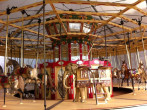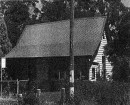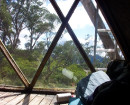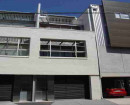CAROUSEL
ROYAL MELBOURNE ZOOLOGICAL GARDENS, ELLIOTT AVENUE PARKVILLE, MELBOURNE CITY
-
Add to tour
You must log in to do that.
-
Share
-
Shortlist place
You must log in to do that.
- Download report
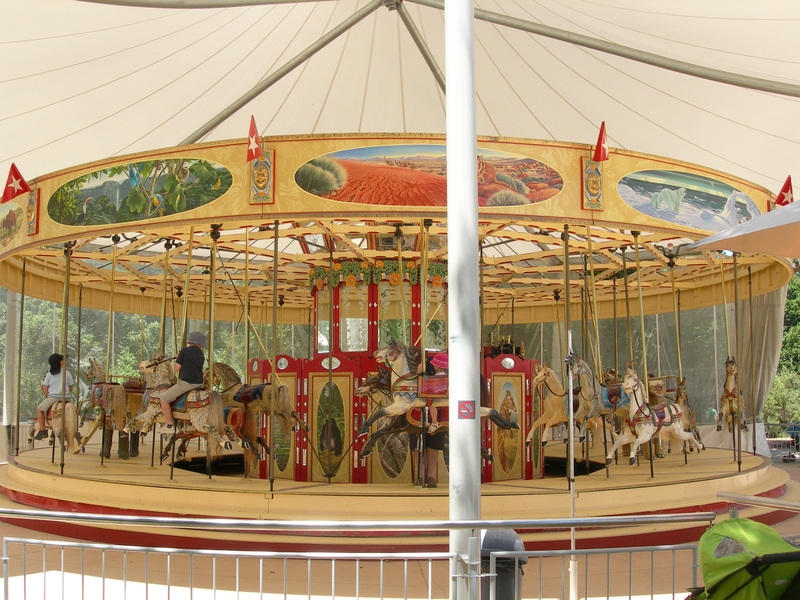




Statement of Significance
What is significant?
The Carousel was imported to Australia from London in 1886 by John and Margaret Briggs. It was purchased for touring around country Victoria. The structure was originally demountable for visits to fairs, a long English tradition which climaxed in the early twentieth century when sometimes up to 100 Carousels and other whirling rides dominated market towns and fairgrounds. Some of the Victorian localities are commemorated in the painted scenes decorating the outer rounding board, and the inner panels, for example 'Swan Hill show 1897'. The manufacturer of the Carousel is believed to have been Tidman of England and the horses probably were supplied by Lines although some may be by Orton and Spooner. The Carousel retains its original steam power mechanism although it is now driven by electric motor. The Carousel consists of three rows of horses which are modelled in a rather rigid and formal posture. There are also two replica fibreglass elephants, which make an appropriate addition to the current zoo setting of the Carousel. The clock-wise rotation of the horses was a typically English feature of the Carousel. The Carousel has been a permanent attraction at the zoo since 1952.
How is it significant?
The Carousel is of historical, social and technological significance to the State of Victoria.
Why is it significant?
The Carousel is historically significant as an extremely rare and substantially intact example of a nineteenth century Carousel. Fewer than two hundred Carousels are known to survive world-wide, the majority of which are in America. The Carousel, through its close association with the Briggs and Freeman families, and by paintings which adorn its structure, demonstrates the nature of travelling fairs and fairground entertainment in the late nineteenth and early twentieth centuries. The Carousel is a rare survivor of the way of life of travelling fairs. The craftsmanship and styling of the carved horses is representative of nineteenth century British production, which was generally more realistic than the flamboyant American examples, such as those at the Luna Park Carousel.
The Carousel is socially significant for its associations with the Royal Melbourne Zoological Gardens. The ride forms a representative type of entertainment to be found at the Zoo for much of the later part of the twentieth century.
The Carousel is technologically significant for retaining its original steam powered mechanism and steam generating equipment. The Tidman centre engine is a very rare example of its type. This nineteenth century application of steam power to a fairground attraction was a technological innovation.
-
-
CAROUSEL - History
History of Place:
(from National Trust file G45 on Trust's website: http://nattrust.australia-online.com.au
The carousel, although installed in 1952, now demonstrates the emphasis on leisure from this phase and was complementary to the elephant walk. The carousel/merry-go-round is English and was constructed before 1886, when it arrived in the colony. It features stilted horses, like rocking horses, which were typically English as was the clock-wise motion of the horses. The structure was originally demountable for visits to fairs, another long English tradition, which climaxing in the early twentieth century when sometimes up to 100 carousels and other whirling rides dominating market towns and fairgrounds. There is also a long tradition of Gipsy family involvement in fairs. Mr and Mrs Briggs imported the carousel originally, and toured it around country Victoria. Some of the localities are commemorated in the painted scenes decorating the outer rounding board, and the inner panels e.g. 'Swan Hill show 1897'. The carousel is still operated by 'Briggs and Freeman entertainments and is not owned by Zoo. Other carousels/merry-go-rounds which survive in Australia are as follows:
Victoria: Luna Park (USA, 1913); Wittingslow Amusements have two demountable merry-go-rounds, one from the 1880s and the other 1947.
New South Wales: Kale's (England, c.1880); there are also two demountable merry-go- rounds still operating in New South Wales.
South Australia: Baxter's Carousel (c.1905)
Australian Capital Weninger's Steam Riding Gallery (1913, local origin but with
Territory: German horses)
Western Australia: Perth Zoo (c.1880)
The carousel at Melbourne Zoo is well maintained and the repaint the horses and other parts are repainted periodically in garish but suitably ornate colours. The carousel is an early example of its kind, relates to the leisure tradition at the zoo and forms a notable example of folk/naive art
Associated People: Tidman
Briggs & FreemanCAROUSEL - Permit Exemptions
General Exemptions:General exemptions apply to all places and objects included in the Victorian Heritage Register (VHR). General exemptions have been designed to allow everyday activities, maintenance and changes to your property, which don’t harm its cultural heritage significance, to proceed without the need to obtain approvals under the Heritage Act 2017.Places of worship: In some circumstances, you can alter a place of worship to accommodate religious practices without a permit, but you must notify the Executive Director of Heritage Victoria before you start the works or activities at least 20 business days before the works or activities are to commence.Subdivision/consolidation: Permit exemptions exist for some subdivisions and consolidations. If the subdivision or consolidation is in accordance with a planning permit granted under Part 4 of the Planning and Environment Act 1987 and the application for the planning permit was referred to the Executive Director of Heritage Victoria as a determining referral authority, a permit is not required.Specific exemptions may also apply to your registered place or object. If applicable, these are listed below. Specific exemptions are tailored to the conservation and management needs of an individual registered place or object and set out works and activities that are exempt from the requirements of a permit. Specific exemptions prevail if they conflict with general exemptions. Find out more about heritage permit exemptions here.
-
-
-
-
-
MOUNT ROYAL HOSPITAL
 Victorian Heritage Register H1725
Victorian Heritage Register H1725 -
FORMER POLICE STATION COMPLEX
 Victorian Heritage Register H1545
Victorian Heritage Register H1545 -
DELORAINE TERRACE
 Victorian Heritage Register H0098
Victorian Heritage Register H0098
-
'Lawn House' (Former)
 Hobsons Bay City
Hobsons Bay City -
1 Fairchild Street
 Yarra City
Yarra City -
10 Richardson Street
 Yarra City
Yarra City
-
-
Images See all images






